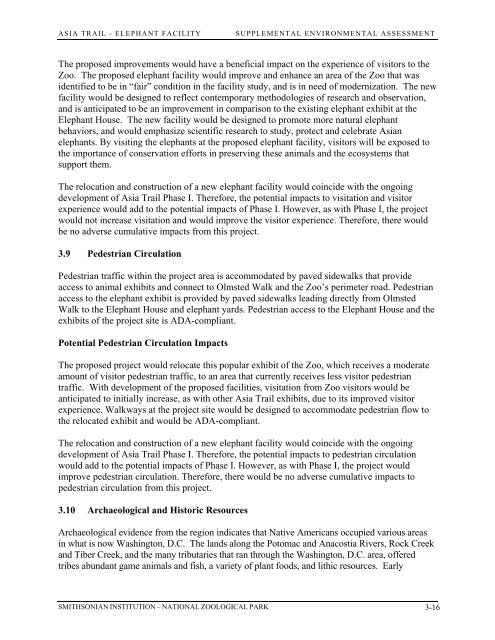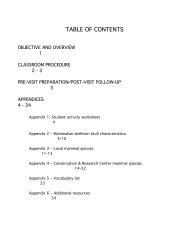asia trail elephant facility - National Zoo - Smithsonian Institution
asia trail elephant facility - National Zoo - Smithsonian Institution
asia trail elephant facility - National Zoo - Smithsonian Institution
Create successful ePaper yourself
Turn your PDF publications into a flip-book with our unique Google optimized e-Paper software.
ASIA TRAIL - ELEPHANT FACILITY SUPPLEMENTAL ENVIRONMENTAL ASSESSMENT<br />
The proposed improvements would have a beneficial impact on the experience of visitors to the<br />
<strong>Zoo</strong>. The proposed <strong>elephant</strong> <strong>facility</strong> would improve and enhance an area of the <strong>Zoo</strong> that was<br />
identified to be in “fair” condition in the <strong>facility</strong> study, and is in need of modernization. The new<br />
<strong>facility</strong> would be designed to reflect contemporary methodologies of research and observation,<br />
and is anticipated to be an improvement in comparison to the existing <strong>elephant</strong> exhibit at the<br />
Elephant House. The new <strong>facility</strong> would be designed to promote more natural <strong>elephant</strong><br />
behaviors, and would emphasize scientific research to study, protect and celebrate Asian<br />
<strong>elephant</strong>s. By visiting the <strong>elephant</strong>s at the proposed <strong>elephant</strong> <strong>facility</strong>, visitors will be exposed to<br />
the importance of conservation efforts in preserving these animals and the ecosystems that<br />
support them.<br />
The relocation and construction of a new <strong>elephant</strong> <strong>facility</strong> would coincide with the ongoing<br />
development of Asia Trail Phase I. Therefore, the potential impacts to visitation and visitor<br />
experience would add to the potential impacts of Phase I. However, as with Phase I, the project<br />
would not increase visitation and would improve the visitor experience. Therefore, there would<br />
be no adverse cumulative impacts from this project.<br />
3.9 Pedestrian Circulation<br />
Pedestrian traffic within the project area is accommodated by paved sidewalks that provide<br />
access to animal exhibits and connect to Olmsted Walk and the <strong>Zoo</strong>’s perimeter road. Pedestrian<br />
access to the <strong>elephant</strong> exhibit is provided by paved sidewalks leading directly from Olmsted<br />
Walk to the Elephant House and <strong>elephant</strong> yards. Pedestrian access to the Elephant House and the<br />
exhibits of the project site is ADA-compliant.<br />
Potential Pedestrian Circulation Impacts<br />
The proposed project would relocate this popular exhibit of the <strong>Zoo</strong>, which receives a moderate<br />
amount of visitor pedestrian traffic, to an area that currently receives less visitor pedestrian<br />
traffic. With development of the proposed facilities, visitation from <strong>Zoo</strong> visitors would be<br />
anticipated to initially increase, as with other Asia Trail exhibits, due to its improved visitor<br />
experience. Walkways at the project site would be designed to accommodate pedestrian flow to<br />
the relocated exhibit and would be ADA-compliant.<br />
The relocation and construction of a new <strong>elephant</strong> <strong>facility</strong> would coincide with the ongoing<br />
development of Asia Trail Phase I. Therefore, the potential impacts to pedestrian circulation<br />
would add to the potential impacts of Phase I. However, as with Phase I, the project would<br />
improve pedestrian circulation. Therefore, there would be no adverse cumulative impacts to<br />
pedestrian circulation from this project.<br />
3.10 Archaeological and Historic Resources<br />
Archaeological evidence from the region indicates that Native Americans occupied various areas<br />
in what is now Washington, D.C. The lands along the Potomac and Anacostia Rivers, Rock Creek<br />
and Tiber Creek, and the many tributaries that ran through the Washington, D.C. area, offered<br />
tribes abundant game animals and fish, a variety of plant foods, and lithic resources. Early<br />
SMITHSONIAN INSTITUTION – NATIONAL ZOOLOGICAL PARK 3-16
















